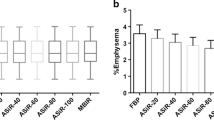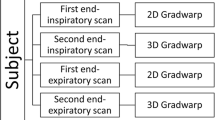Abstract
Purpose
The authors assessed the reproducibility of multidetector-row computed tomography (MDCT) volumetry of the total and emphysematous parenchyma of pulmonary lobes.
Materials and methods
Two observers analyzed 23 MDCT examinations of patients with emphysema during two sessions held 3 months apart. Both lungs and all lobes were delimited by a combination of semiautomated and manual segmentation. Emphysematous parenchyma was obtained by applying density thresholds of −1,024/−950 HU. To assess the reproducibility of total volume (V), volume of emphysema (VE) and emphysema index (EI), intra- and interobserver differences of those measurements were assessed.
Results
Total volumetry of the lungs was highly reproducible (intra- and interobserver variability of ±3.4%). Variability between measurements was slightly greater or emphysema volume and index (EI). Lobar analyses showed large ranges of intra- and interobserver variability (intraobserver V=±3.7%–10.6%; VE=±17.3%–32.9%; EI=±17.8%–34%; interobserver V=±13.3%–98.3%; VE=±11%–137.6%; EI=±28.9%–96.4%).
Conclusions
MDCT quantification of total and emphysematous lung volume and emphysema index is overall reproducible. Quantitative assessment of those parameters performed on single lobes is affected by variability. An improvement of the reproducibility of q-MDCT is expected from the use of advanced methods for lobar segmentation.
Riassunto
Obiettivo
Lo scopo del nostro studio è stato quello di valutare la riproducibilità della volumetria in tomografia computerizzata multidetettore (MDTC) del parenchima polmonare lobare totale ed enfisematoso.
Materiali e metodi
In due sessioni a distanza di tre mesi, due operatori hanno analizzato 23 esami MDTC del torace di pazienti con enfisema polmonare. Con una procedura semiautomatica e manuale sono stati delimitati i due polmoni ed i lobi. Il parenchima enfisematoso è stato ottenuto applicando un range densitometrico di −1024/−950 unità Hounsfield (HU). La riproducibilità del volume totale (V), d’enfisema (VE) e dell’indice d’enfisema (EI) è stata valutata calcolando le differenze intra- ed interosservatore tra le misurazioni.
Risultati
La volumetria totale per polmoni è risultata complessivamente riproducibile, con variabilità intra- ed interossevatore tra le misurazioni di ±3,4%. La variabilità tra le misurazioni è stata lievemente maggiore per il volume e l’indice d’enfisema. Le volumetrie lobari hanno presentato range di variabilità maggiori nell’analisi intraosservatore e nettamente superiori in quella interosservatore (intra-osservatore: V=±3,7%–10,6%; VE=±17,3%–32,9%; EI=±17,8%–34%; interosservatore: V=±13,3%–98,3%; VE=±11%–137,6%; EI=±28,9%–96,4%).
Conclusioni
La quantificazione MDTC del volume polmonare totale, della frazione d’enfisema e dell’indice d’enfisema è complessivamente riproducibile. Sui singoli lobi, l’analisi volumetrica presenta maggiore variabilità. Ai fini dell’applicazione clinica, l’impiego di software per la segmentazione automatica potrà fornire valori di riproducibilità migliori per la volumetria MDTC quantitativa lobare.
Similar content being viewed by others
References/Bibliografia
Wu MT, Pan HB (2002) Prediction of postoperative lung function in patients with lung cancer: comparison of quantitative CT with perfusion scintigraphy. AJR Am J Roentgenol 178:667–672
Beckles MA, Spiro SG (2003) The physiologic evaluation of patients with lung cancer being considered for resectional surgery. Chest 123:105S–114S
Gierada DS, Slone RM (1997) Pulmonary emphysema: comparison of preoperative quantitative CT and physiologic index values with clinical outcome after lung-volume reduction surgery. Radiology 205:235–242
Hunsaker AR, Ingenito EP (2002) Lung volume reduction surgery for emphysema: correlation of CT and V/Q imaging with physiologic mechanisms of improvement in lung function. Radiology 222:491–498
Slone RM, Pilgram TK (1997) Lung volume reduction surgery: comparison of preoperative radiologic features and clinical outcome. Radiology 204:685–693
Gierada DS, Yusen RD (2000) Patient selection for lung volume reduction surgery: An objective model based on prior clinical decisions and quantitative CT analysis. Chest 117:991–998
National Emphysema Treatment Trial Research Group (2001) Patients at high risk of death after lung-volume-reduction surgery. N Engl J Med 345:1075–1083
Leroy S, Marquette CH (2004) [VENT: International study of bronchoscopic lung volume reduction as a palliative treatment for emphysema]. Revue des Maladies Respiratoires 21:1144–1152
Fraioli F, Calabrese FA (2006) MDCT assessment of lung volume in patients undergoing bronchial stenting for treatment of pulmonary emphysema: correlation with respiratory tests and personal experience. Radiol Med 111:749–758
Strange C, Herth FJ (2007) Design of the endobronchial valve for emphysema palliation trial (VENT): a non-surgical method of lung volume reduction. BMC Pulm Med 7:10
Revel MP, Faivre JB (2008) Automated lobar quantification of emphysema in patients with severe COPD. Eur Radiol 18:2723–2730
Sverzellati N, Calabro E (2007) Visual score and quantitative CT indices in pulmonary fibrosis: Relationship with physiologic impairment. Radiol Med 112:1160–1172
Stern EJ, Frank MS (1994) CT of the lung in patients with pulmonary emphysema: diagnosis, quantification, and correlation with pathologic and physiologic findings. AJR Am J Roentgenol 162:791–798
Madani A, Keyzer C (2001) Quantitative computed tomography assessment of lung structure and function in pulmonary emphysema. Eur Respir J 18:720–730
Goldin JG (2002) Quantitative CT of the lung. Radiol Clin North Am 40:145–162
Matsuoka S, Kurihara Y (2008) Quantitative assessment of air trapping in chronic obstructive pulmonary disease using inspiratory and expiratory volumetric MDCT. AJR Am J Roentgenol 190:762–769
Park KJ, Bergin CJ (1999) Quantitation of emphysema with three-dimensional CT densitometry: comparison with two-dimensional analysis, visual emphysema scores, and pulmonary function test results. Radiology 211:541–547
Pescarolo M, Sverzellati N (2008) How much do GOLD stages reflect CT abnormalities in COPD patients? Radiol Med 113:817–829
Bland JM, Altman DG (1986) Statistical methods for assessing agreement between two methods of clinical measurement. Lancet 1:307–310
Murray GD, Miller R (1990) Statistical comparison of two methods of clinical measurement. Br J Surg 77:385–387
Halligan S (2002) Reproducibility, repeatability, correlation and measurement error. Br J Radiol 75:193–194
Gierada DS, Yusen RD (2001) Repeatability of quantitative CT indexes of emphysema in patients evaluated for lung volume reduction surgery. Radiology 220:448–454
Stolk J, Dirksen A (2001) Repeatability of lung density measurements with low-dose computed tomography in subjects with alpha-1-antitrypsin deficiency-associated emphysema. Invest Radiol 36:648–651
Malinen A, Erkinjuntti-Pekkanen R (2002) Reproducibility of scoring emphysema by HRCT. Acta Radiologica 43:54–59
Bakker ME, Stolk J (2005) Variability in densitometric assessment of pulmonary emphysema with computed tomography. Investigative Radiology 40:777–783
Sverzellati N, Chetta A (2005) Reliability of quantitative computed tomography to predict postoperative lung function in patients with chronic obstructive pulmonary disease having a lobectomy. J Comput Assist Tomogr 29:819–824
Author information
Authors and Affiliations
Corresponding author
Rights and permissions
About this article
Cite this article
Molinari, F., Amato, M., Stefanetti, M. et al. Density-based MDCT quantification of lobar lung volumes: a study of inter- and intraobserver reproducibility. Radiol med 115, 516–525 (2010). https://doi.org/10.1007/s11547-010-0536-x
Received:
Accepted:
Published:
Issue Date:
DOI: https://doi.org/10.1007/s11547-010-0536-x




